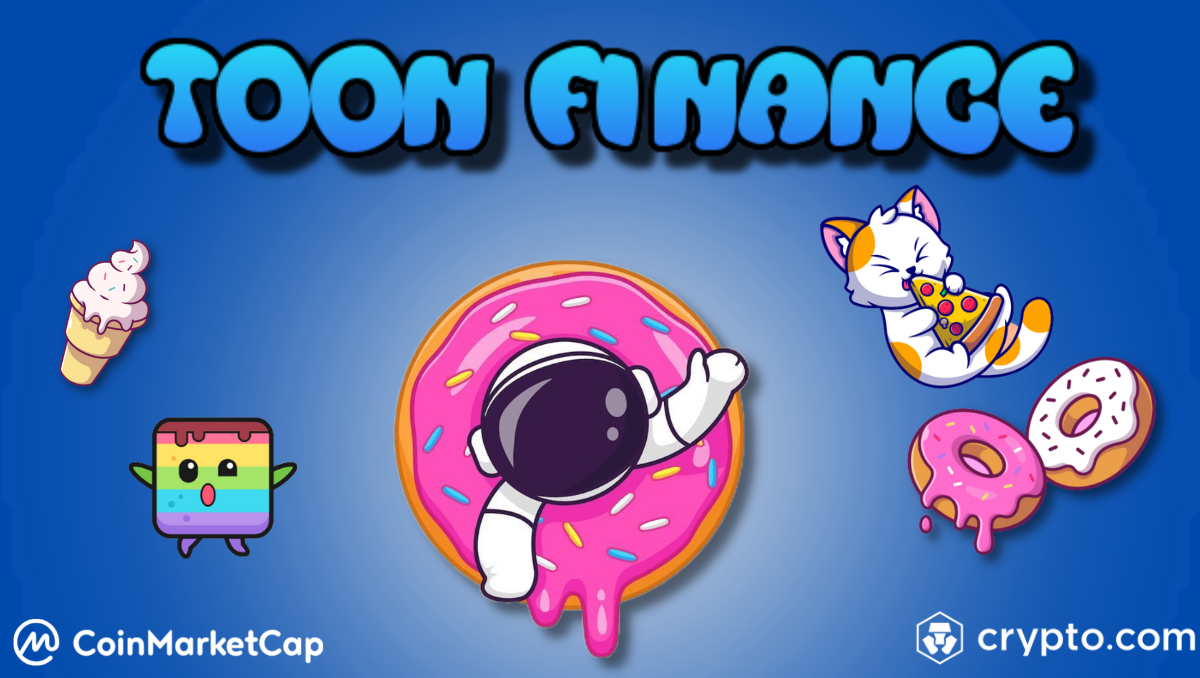



Toon Finance is one of the most talked about and written about coins right now exploding all over the internet from websites all over the world. These writers have been following this project from the day it was born and they are making quite the name for themselves. Toon Finance, the innovative DEX platform that will be similar to pancake swap however servicing the Ethereum blockchain.
Toon Finance DEX is offering one of a kind features with their P2E and Raffle options. Visit the Toon team on Twitter, Telegram or visit their website to see the latest cool artwork. Toon finance has an opportunity to revolutionize the crypto space raising over 2 million during the first phase of their presale.
Toon Finance was recently added to CoinMarketCap and Crypto.com. These are two major players in the crypto space. With so many celebrities getting on the crypto train these days bringing in over a billion dollars annually overall.
These ERC20 tokens that have use cases such as toon finance are necessary for the growth of Ethereum and the space in general by offering more resources to its users and the decentralized finance community.
If you’re like most people, the word “finance” probably conjures up images of Wall Street and suits counting stacks of cash. But what if there was a way to take the power away from the financial institutions that have historically controlled our money and put it back into the hands of regular people? That’s the goal of decentralized finance, or “DeFi.”
In its simplest form, DeFi is a digital ecosystem of financial applications built on Ethereum, a decentralized blockchain network. By using Ethereum’s smart contract functionality, DeFi developers are able to create financial protocols and platforms that run exactly as programmed and that are available to anyone with an internet connection.
What this means is that, for the first time ever, individuals can access a wide range of financial services—including lending, borrowing, trading, and investing—without having to go through a traditional financial institution. And because these services are built on Ethereum, they can be used by anyone in the world without having to worry about censorship or interference from a central authority.
The potential implications of this are huge. For millions of people around the world who don’t have access to traditional financial services, DeFi could provide a much-needed lifeline. And for those of us who are tired of being at the mercy of banks and other financial institutions, DeFi offers a way to take back control of our money.
As we mentioned before, DeFi is built on Ethereum, which means that all DeFi applications run on Ethereum’s decentralized network. This is possible because of Ethereum’s smart contract functionality, which allows developers to create contracts that will execute automatically when certain conditions are met.
For example, let’s say you want to borrow money from a friend. In the past, you would have had to work out an agreement between the two of you and then hope that your friend remembers to give you the money when they said they would. With a smart contract, however, you can set up an agreement whereby your friend sends you the money automatically on a specific date—and if they don’t, they forfeit the loan.
This same principle can be applied to lending, borrowing, trading, and investing—all without having to go through a bank or other financial institution. And because these transactions are taking place on Ethereum’s decentralized network, they’re not subject to censorship or interference from any central authority.
The most obvious benefit of DeFi is that it gives individuals access to financial services that they wouldn’t otherwise have. For example, there are currently over 2 billion adults around the world who don’t have a bank account—but with DeFi, they can now send and receive payments without having to go through a bank.
DeFi also has the potential to democratize investing. In the past, only accredited investors—those with high incomes and net worths—were able to participate in investments like venture capital and private equity. But with DeFi protocols like MakerDAO and Compound Finance, anyone can now earn interest on their cryptocurrency holdings by lending them out to borrowers.
Perhaps most importantly, DeFi represents a fundamental shift in power away from financial institutions and towards regular people.
With traditional finance, we have always been at the mercy of banks and other institutions; if they decide to raise interest rates or change their policies, there’s not much we can do about it. But with DeFI protocols like MakerDAO and Compound Finance , we now have control over our own money . . . which means we can finally start dictating terms instead of being dictated TO! . .
So what does all this mean for the future of finance? Only time will tell—but one thing is for sure: Decentralized finance represents a major step forward in giving power back to regular people . . . which means it’s something worth paying attention to! Thanks for reading!
Blog Introduction: Casper is a cryptocurrency platform that uses proof-of-stake (PoS) consensus. The native token of the Casper network is called CSPR. The Casper platform is designed to boost the adoption of blockchain technology, smart contracts, and DApps on a global scale.
The Casper network uses a hybrid PoS/PoW consensus algorithm. Under this system, block validators are chosen based on their stake in the network. The more CSPR tokens a user holds, the greater their chances of being selected as a block validator.
In addition to staking CSPR tokens, users can also earn rewards by participating in governance decisions and contributing to the network in other ways. For example, users can submit bug reports or suggest new features.
Casper Benefits
The main benefit of the Casper platform is its focus on scalability. The hybrid PoS/PoW consensus algorithm enables the Casper network to process more transactions per second than other PoS-based networks.
Another benefit of the Casper platform is its security model. Because block validators are chosen based on their stake in the network, there is a strong incentive for them to act in the best interests of the network. This incentive system helps to protect the network from malicious actors and 51% attacks.
Casper is a promising new cryptocurrency platform that offers scalability and security advantages over other PoS-based networks.
The native token of the Casper network, CSPR, can be staked in order to earn rewards and participate in governance decisions. The Casper platform is designed to boost the adoption of blockchain technology, smart contracts, and DApps on a global scale.
Blog Introduction: In this blog post, we’ll be giving a comprehensive introduction to Chainlink (LINK). We’ll cover what it is, how it works, and some of its key features. By the end of this post, you should have a good understanding of what Chainlink is and how it can be used. So, let’s get started!
Chainlink is a blockchain abstraction layer that enables universally connected smart contracts. Through a decentralized oracle network, Chainlink allows blockchains to securely interact with external data feeds, events and payment methods, providing the critical off-chain information needed by complex smart contracts to become the dominant form of digital agreement.
In other words, Chainlink is a decentralized network that provides reliable data to smart contracts. This data includes things like prices, weather conditions, sports scores, etc.
Chainlink works by connecting blockchain-based smart contracts to external data sources through what are called “oracles.” Oracles are nodes in the network that retrieve data from off-chain sources and relay it back to the smart contract. This way, the contract can use this data to execute its functions.
For example, let’s say there’s a smart contract that’s supposed to pay out insurance claims when the temperature exceeds 30 degrees Celsius. The contract can’t do this on its own because it doesn’t have access to temperature data. However, with Chainlink, the contract can connect to an oracle that retrieves this data from an external source. Once the oracle has this data, it relays it back to the contract so that the contract can pay out the insurance claims accordingly.
Now that we know what Chainlink is and how it works, let’s take a look at some of its key features:
Decentralized Network
One of the key advantages of Chainlink is that it’s decentralized. This means that there is no single point of failure and the network is more resistant to attacks.
Chainlink is a decentralized network that provides reliable data to smart contracts. It does this by connecting blockchain-based smart contracts to external data sources through what are called “oracles.”
Oracles are nodes in the network that retrieve data from off-chain sources and relay it back to the smart contract. Some key advantages of Chainlink include its decentralization, high security, and reliability.
Avalanche is a layer one blockchain that functions as a platform for decentralized applications and custom blockchain networks. It is one of Ethereum’s rivals, aiming to unseat Ethereum as the most popular blockchain for smart contracts. It aims to do so by having a higher transaction output of up to 6,500 transactions per second while not compromising scalability. In this blog post, we will explore what Avalanche is, how it works, and its potential implications for the crypto industry.
Avalanche is a layer one blockchain that functions as a platform for decentralized applications and custom blockchain networks. It is one of Ethereum’s rivals, aiming to unseat Ethereum as the most popular blockchain for smart contracts. It aims to do so by having a higher transaction output of up to 6,500 transactions per second while not compromising scalability.
Avalanche utilizes something called consensus by bet to reach agreement on the state of the network. Consensus by bet is similar to proof of work in that it incentivizes nodes (computers that are connected to the network) to put forth computational power in order to validate transactions. However, consensus by bet is more energy efficient than proof of work because it does not require nodes to repeatedly solve complex math problems in order to validate transactions.
In addition, Avalanche utilizes a novel consensus protocol called Snowflake which allows for faster transaction times and increased scalability. Snowflake achieves this by allowing any node on the network to be a validator—unlike other consensus protocols which require specialized hardware in order to validate transactions.
If Avalanche is successful in unseating Ethereum as the most popular blockchain for smart contracts, it could have major implications for the crypto industry. For one, it would mean that developers would have to learn a new programming language (Avalanche’s native programming language is called Ava) in order to develop on the platform. Additionally, it could lead to more competition among blockchains as developers flock to whichever platform offers the most features and functionality.
Avalanche is a layer one blockchain that functions as a platform for decentralized applications and custom blockchain networks. It is one of Ethereum’s rivals, aiming to unseat Ethereum as the most popular blockchain for smart contracts. It aims to do so by having a higher transaction output of up to 6,500 transactions per second while not compromising scalability.
In this blog post, we explored what Avalanche is, how it works, and its potential implications for the crypto industry. While only time will tell if Avalanche will be successful in unseating Ethereum, it is certainly a project worth paying attention to in the coming months and years.
Twitter | Toon Finance | Telegram
Those who enter the market at this time may be surprised to hear that Bitcoin…
George Town, Grand Cayman, 22nd November 2024, Chainwire
Las Vegas, US, 1st November 2024, Chainwire
From digital art to real-estate assets, NFTs have become a significant attraction for investors who…
Singapore, Singapore, 21st October 2024, Chainwire
HO CHI MINH, Vietnam, 17th October 2024, Chainwire